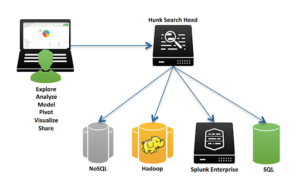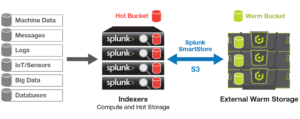Request a Demo
Join a 30 minute demo with a Cloudian expert.
Splunk is a popular platform for big data collection and analytics, often used to derive insights from huge volumes of machine data. There are two primary ways to use Splunk architecture for data analytics:
In this article we focus on the second method, explaining how Hunk can help you make sense of legacy Hadoop datasets.
In this article you will learn:
This is part of a series of articles about Splunk Architecture.
Splunk is an innovative technology which searches and indexes log files and helps organizations derive insights from the data. A main benefit of Splunk is that it uses indexes to store data, and so does not require a separate database to store its information.
Splunk is used for monitoring and searching through big data. It indexes and correlates information in a container that makes it searchable, and makes it possible to generate alerts, reports and visualizations. It can recognize data patterns, create metrics and help diagnose problems, for business challenges like IT management, security and compliance.
Splunk helps organizations extract value from server data. This enables efficient application management, IT operations management, compliance and security monitoring.
At the center of Splunk is an engine that collects, indexes and manages big data. It can handle terabytes of data or more in any format every day. Splunk analyzes data dynamically, creating schemas on the fly, allowing organizations to query data without having to understand the data structure first. It’s simply possible to pour data into Splunk and immediately begin analysis.
Splunk can be deployed on a single laptop or in a massive, distributed architecture in an enterprise data center. It provides a machine data fabric, including forwarders, indexers and search heads (see our article on Splunk architecture) that enables real-time collection and indexing of machine data from any network, data center or IT environment.
Hunk is an alternative to Splunk Enterprise, provided and supported by Splunk, for analyzing machine data stored in Hadoop. In the past, many organizations saved machine data in Hadoop because it was the go-to tool for storing and analyzing very big data. Today, as the Hadoop ecosystem ages, organizations are struggling with its limitations.

Source: Splunk
Hunk is a Splunk big data solution designed to explore and visualize data in Hadoop clusters and NoSQL databases like Apache Cassandra. Instead of writing code in Hadoop for every data-related question you need to ask, Hunk provides an integrated experience that does not require special skills, and can help you extract insights from big data without specialized schemas or a major development effort.
Hunk can help organizations make more of Hadoop datasets by:
Hunk can perform the following functions:
If your data is stored in Hadoop, Hunk is the obvious choice because it can operate directly on the data with no need for large-scale data intake. However, if you have the option of extracting data from Hadoop, the question arises whether it might be better to switch from Hadoop to Splunk Enterprise.
Advantages of Hunk:
Advantages of Splunk Enterprise:
To get the most out of Splunk Hunk and ensure optimal performance and results, it’s essential to follow some best practices:
By following these best practices, organizations can maximize the benefits of Splunk Hunk and ensure that their data analytics efforts deliver the best possible results. With Splunk Hunk and Hadoop working together, companies can unlock the full potential of their data, driving better decision-making and paving the way for innovation and growth.
Read more in our guides to splunk big data and splunk backup.
Splunk’s new SmartStore feature allows the indexer to index data on cloud storage such as Amazon S3. Cloudian HyperStore is an S3-compatible, exabyte-scalable on-prem storage pool that SmartStore can connect to. Cloudian lets you decouple compute and storage in your Splunk architecture and scale up storage independently of compute resources.

HyperStore also features full Apache Hadoop integration for Splunk Hunk users. Orgnizations can run Hadoop analytics on HyperStore appliances, with no need to offload data to other systems. Under the hood, HyperStore uses S3FS as the target for HDFS, allowing you to run Map Reduce jobs on top of data stored on a Cloudian appliance.
Learn more about Cloudian’s solution for Splunk storage or big data systems including Hadoop/HDFS.